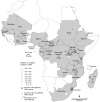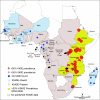Drug resistance maps to guide intermittent preventive treatment of malaria in African infants
- PMID: 21835078
- PMCID: PMC3178874
- DOI: 10.1017/S0031182011000746
Drug resistance maps to guide intermittent preventive treatment of malaria in African infants
Abstract
Intermittent preventive treatment of infants (IPTi) with sulphadoxine pyrimethamine (SP) is recommended as an additional malaria control intervention in high transmission areas of sub-Saharan Africa, provided its protective efficacy is not compromised by SP resistance. A significant obstacle in implementing SP-IPTi, is in establishing the degree of resistance in an area. Since SP monotherapy is discontinued, no contemporary measures of in vivo efficacy can be made, so the World Health Organisation has recommended a cut-off based upon molecular markers, stating that SP-IPTi should not be implemented when the prevalence of the dhps 540E mutation among infections exceeds 50%. We created a geo-referenced database of SP resistance markers in Africa from published literature. By selecting surveys of malaria infected blood samples conducted since 2004 we have mapped the contemporary prevalence of dhps 540E. Additional maps are freely available in interactive form at http://www.drugresistancemaps.org/ipti/. Eight countries in East Africa are classified as unsuitable for SP-IPTi when data are considered at a national level. Fourteen countries in Central and West Africa were classified as suitable while seven countries had no available contemporary data to guide policy. There are clear deficiencies in molecular surveillance data coverage. We discuss requirements for ongoing surveillance of SP resistance markers in support of the use of SP-IPTi.
Figures




References
-
- Alifrangis M., Lusingu J. P., Mmbando B., Dalgaard M. B., Vestergaard L. S., Ishengoma D., Khalil I. F., Theander T. G., Lemnge M. M., Bygbjerg I. C.. Five-year surveillance of molecular markers of Plasmodium falciparum antimalarial drug resistance in Korogwe District, Tanzania: accumulation of the 581G mutation in the P. falciparum dihydropteroate synthase gene. American Journal of Tropical Medicine and Hygiene. 2009;80:523–527. - PubMed
-
- Alker A. P., Mwapasa V., Purfield A., Rogerson S. J., Molyneux M. E., Kamwendo D. D., Tadesse E., Chaluluka E., Meshnick S. R.. Mutations associated with sulfadoxine-pyrimethamine and chlorproguanil resistance in Plasmodium falciparum isolates from Blantyre, Malawi. Antimicrobial Agents and Chemotherapy. 2005;49:3919–3921. - PMC - PubMed
-
- Andriantsoanirina V., Ratsimbasoa A., Bouchier C., Jahevitra M., Rabearimanana S., Radrianjafy R., Andrianaranjaka V., Randriantsoa T., Rason M. A., Tichit M., Rabarijaona L. P., Mercereau-Puijalon O., Durand R., Menard D.. Plasmodium falciparum drug resistance in Madagascar: facing the spread of unusual pfdhfr and pfmdr-1 haplotypes and the decrease of dihydroartemisinin susceptibility. Antimicrobial Agents and Chemotherapy. 2009;53:4588–4597. - PMC - PubMed
-
- Aponte J. J., Schellenberg D., Egan A., Breckenridge A., Carneiro I., Critchley J., Danquah I., Dodoo A., Kobbe R., Lell B., May J., Premji Z., Sanz S., Sevene E., Soulaymani-Becheikh R., Winstanley P., Adjei S., Anemana S., Chandramohan D., Issifou S., Mockenhaupt F., Owusu-Agyei S., Greenwood B., Grobusch M. P., Kremsner P. G., Macete E., Mshinda H., Newman R. D., Slutsker L., Tanner M., Alonso P., Menendez C.. Efficacy and safety of intermittent preventive treatment with sulfadoxine-pyrimethamine for malaria in African infants: a pooled analysis of six randomised, placebo-controlled trials. Lancet. 2009;374:1533–1542. - PubMed
-
- Bell D. J., Nyirongo S. K., Mukaka M., Zijlstra E. E., Plowe C. V., Molyneux M. E., Ward S. A., Winstanley P. A.. Sulfadoxine-pyrimethamine-based combinations for malaria: a randomised blinded trial to compare efficacy, safety and selection of resistance in Malawi. PLoS ONE. 2008;3:e1578. - PMC - PubMed
Publication types
MeSH terms
Substances
Grants and funding
LinkOut - more resources
Full Text Sources
Medical

